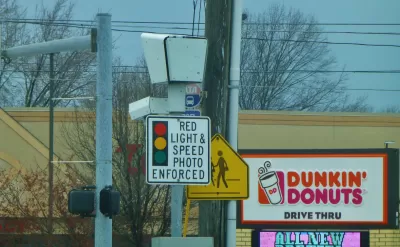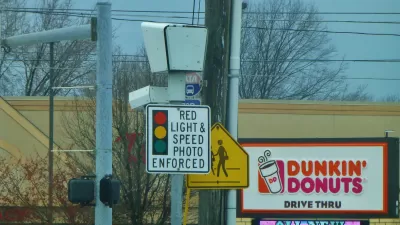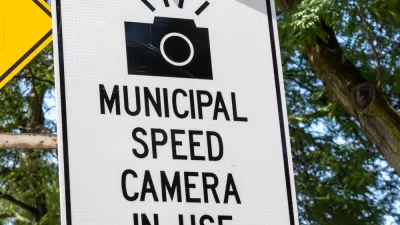Gov. Andrew M. Cuomo took his mother to work on Sunday so she could join him in a panel where he signed life-saving, street safety legislation to reinstate and expand the school zone speed camera program in New York City.

In an email titled, "To all the mothers in New York," sent, appropriately, on Mother's Day, the New York State governor writes, "Earlier today my mother joined me to sign life-saving legislation to expand camera speed zones in New York City."
"Speed cameras work - it is just undeniable," states Gov. Andrew M. Cuomo in the video of the panel discussion on May 12 that preceded his signing two bills, S.4331 by Sen. Andrew Gounardes (D-Brooklyn) and A.6449 by Assemblymember Deborah J. Glick (D-Manhattan), to continue and expand the operation of photo speed violation monitoring systems in school speed zones in New York City.
Since the activation of the cameras, the number of people killed or severely injured in crashes in school zones with speed cameras declined by 21 percent, and the rate of daily violations for excessive speeding has declined by over 60 percent.
"This bill will increase the number from 140 to 750 speed cameras in the city, extend the hours of operation of the speed cameras and will mandate that the city prioritize placement of the cameras by speed and crash data," states Cuomo.
A 2015 post about a study on the effectiveness of speed cameras in Montgomery County, Md., confirms Cuomo's afore-mentioned assertion.
“Speed cameras get drivers to ease off the accelerator, and crashes are less likely to be deadly at lower speeds,” said Insurance Institute for Highway Safety President Adrian Lund. “This study connects the dots to show that speed cameras save lives.”
The governor's press release (source article) recounts the legislative history of this particular type of automated traffic enforcement.
This legislation reinstates and expands a bill signed by the Governor in 2013 authorizing the city to develop the program using camera technology to record and enforce speeding violation in school zones. Upon the program's expiration in July 2018, and after the Republican-controlled Senate failed to extend the authority before the end of the legislative session, Governor Cuomo signed an executive order [declaring a "state of emergency"] allowing the city to impose the same fines authorized under the expired law and access data from the DMV to carry out the program for the 2018-19 school year.
Also on the panel was Amy Cohen, a safe streets activist who lost her 12-year-old son in a traffic crash in 2013 in Park Slope, Brooklyn, and now works with Families for Safe Streets and Transportation Alternatives to fight for safer streets.
"This is a historic moment recognizing that traffic violence is preventable, and it could never have happened without the leadership of Gov. Cuomo," said Cohen.
California bill stalled
On the West Coast, speed camera legislation that would have authorized a pilot program in Northern California's two largest cities, San Jose and San Francisco, was DOA at its second committee hearing in January 2018. California lacks laws permitting automated speed enforcement, notes an earlier post on the bill.
Related on Planetizen:
-
San Francisco and San Jose Propose Joint Pilot Program for Speed Cameras, February 11, 2017
-
Speed Cameras Have Proven Record of Reducing Speeding, New Study Says, September 3, 2015

Montreal Mall to Become 6,000 Housing Units
Place Versailles will be transformed into a mixed-use complex over the next 25 years.

Planetizen Federal Action Tracker
A weekly monitor of how Trump’s orders and actions are impacting planners and planning in America.

DARTSpace Platform Streamlines Dallas TOD Application Process
The Dallas transit agency hopes a shorter permitting timeline will boost transit-oriented development around rail stations.

Study: 4% of Truckers Lack a Valid Commercial License
Over 56% of inspected trucks had other violations.

Chicago Judge Orders Thousands of Accessible Ped Signals
Only 3% of the city's crossing signals are currently accessible to blind pedestrians.

Philadelphia Swaps Car Lanes for Bikeways in Unanimous Vote
The project will transform one of the handful of streets responsible for 80% of the city’s major crashes.
Urban Design for Planners 1: Software Tools
This six-course series explores essential urban design concepts using open source software and equips planners with the tools they need to participate fully in the urban design process.
Planning for Universal Design
Learn the tools for implementing Universal Design in planning regulations.
City of Mt Shasta
City of Camden Redevelopment Agency
City of Astoria
Transportation Research & Education Center (TREC) at Portland State University
US High Speed Rail Association
City of Camden Redevelopment Agency
Municipality of Princeton (NJ)




























